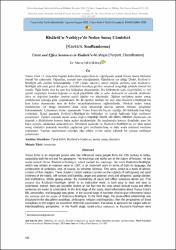Risâletü’n-Nushiyye’de neden sonuç cümleleri (Kavram, Sınıflandırma)
Citation
Demirbaş, M. (2021). Risâletü’n-Nushiyye’de Neden Sonuç Cümleleri (Kavram, Sınıflandırma) . Afyon Kocatepe Üniversitesi Sosyal Bilimler Dergisi , Yunus Emre ve Türkçe Özel Sayısı , 181-197 . DOI: 10.32709/akusosbil.988485Abstract
Yunus Emre 13. yüzyıldan bugüne kadar hem çağını hem de coğrafyasını aşarak birçok insanı etkilemiş önemli bir şahsiyettir. Öğretileri, eserleri ders niteliğindedir. Öğretilerin yer aldığı Divan, Risâletü’nNushiyye adlı eserleri bulunmaktadır. 1307 yılında mesnevi nazım türüyle yazılmış olan Risâletü’nNushiyye adlı eseri gerek dili gerek cümlelerin kuruluşu gerekse anlamsal zenginliği yönüyle önemli bir eserdir. Öğüt kitabı olan bu eser beş bölümden oluşmaktadır. Bu bölümlerde nefis (açgözlülük) ve ruh (gönül zenginliği), kendini beğenme ve alçak gönüllülük, öfke ve sabır, kıskançlık ve cimrilik, dedikoduiftira ve doğruluk konuları üzerine çeşitli öğütler yer almaktadır. Öğütler verilerken neden sonuç cümlelerinin çokluğu göze çarpmaktadır. Bu da öğretici nitelikte bir eser olan Risâletü’n-Nushiyye‟nin hem kolay okunmasını hem de kolay anlamlandırılmasını sağlamaktadır. Nitekim neden sonuç cümlelerinin yer aldığı metinlerin daha kolay anlaşıldığı üzerine yapılan bilimsel çalışmalar bulunmaktadır. Çalışmanın birinci aşamasında Yunus Emre‟nin hayatı, kişiliği, dili hakkında kısa bilgi verilmiştir. İkinci aşamada Risâletü’n-Nushiyye‟nin bölümleri ve içeriği hakkında bilgi verilmeye çalışılmıştır. Üçüncü aşamada neden sonuç ilişkisi sosyoloji, felsefe, din bilimi, dilbilimi alanlarında ele alınarak o disiplinlerin konuya bakış açıları incelenmiştir. Bu incelemeyle konuya disiplinler arası bir bakış açısıyla yaklaşmak amaçlanmıştır. Dördüncü aşamada ise Risâletü’n-Nushiyye‟de yer alan neden sonuç cümleleri taranarak öncelikle yapılarına göre sınıflandırılmış ve daha sonra anlamsal inceleme yapılmıştır. Yapılan incelemenin ardından elde edilen veriler analiz edilerek bir sonuca varılmaya çalışılmıştır. Yunus Emre is an important person who has influenced many people from the 13th century to today, surpassing both his era and his geography. His teachings and works are in the nature of lessons. He has works named Divan, Risâletü‟n-Nushiyye, which include his teachings. His work Risâletü'n-Nushiyye, which was written in masnavi verse in 1307, is an important work in terms of both its language, the construction of sentences, and, of course, its semantic richness. This work, which is a book of advice, consists of five chapters. These chapters contain various counsels on the subjects of nafs (greed) and spirit (richness of the heart), self-conceit and humility, anger and patience, envy and stinginess, gossip-slander, and truthfulness. While giving advice, the multiplicity of cause and effect sentences stands out. This ensures that Risâletü'n-Nushiyye, which is an instructive work, is both easy to read and easy to understand. Indeed, there are scientific studies on the fact that the texts which include cause and effect sentences are easier to understand. In the first stage of the study, short information about Yunus Emre's life, personality, and language was given. In the second stage, it has been tried to give information about the sections and the scope of Risâletü'n-Nushiyye. In the third stage, the cause-effect relationship was discussed in the disciplines sociology, philosophy, religion and linguistics, then the perspectives of those disciplines on the subject are examined. With this examination, it is aimed to approach the subject with an interdisciplinary perspective. In the fourth stage, cause-effect sentences in Risaletü'n-Nushiyye were scanned and classified according to their structures first, and then semantic analysis was made. After the examination, the data obtained were analyzed and a result was tried to be reached.



















